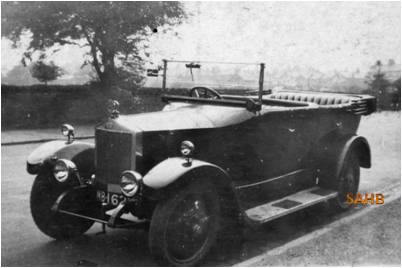
This image is truly a snapshot: taken from a small print in a family photo album. But the car in it is certainly no less fascinating despite the dubious quality of the print.
The history of this American car dates back to 1915. With the important exception of the Ford Model T’s epicyclic gearbox, most vehicle transmissions at that time were still non-synchromesh or ‘crash’ – which was an apt nickname, considering the noise that could be heard as owners tried, and often failed, to mesh their cars’ gears silently.
There thus arose a fashion for cars with alternative transmissions, in particular those using an electrical connection between engine and driving wheels. One of these was the Owen Magnetic, developed in 1915 by Ray M. Owen of the Baker, Rauch & Lang company of Cleveland, Ohio, with an electromagnetic transmission based on Entz patents. Justus Entz, originally an electrician at Thomas Edison’s factory, designed and patented a system that allowed a stepless change of transmission ratio with no need for the inconvenience of clutch or gears.
The Owen Magnetic was advertised as “The Car of a Thousand Speeds” that the driver could control “with the touch of a finger”.
By 1920, J. L. Crown had taken over, and produced cars at Wilkes-Barre, Pennsylvania. Interested in the European market, he ordered 500 cars to be delivered to England, to be sold by Le Grice Elers Ltd of London, who placed a full-page advertisement in the Motor Exhibition Catalogue, Olympia and White City, November 1920, confirming that the car could be seen on Stand 306. Sadly, no more than 20 Crown Magnetics are thought to have been imported before the company closed in 1922.
One apparent reason for the failure of the Crown version of the Magnetic was the omission of the emergency low gear originally fitted on the Owen Magnetics. This turned out to be a mistake: on a long steep hill, the force of gravity on this heavy car could defeat the transmission and could bring the car to a standstill.
The car in our picture, clearly a Crown Magnetic with right-hand drive, was registered at Cheshire County Council as MB 1623 in 1923, and was owned by James Johnston of Birkenhead from 1927. But the hill-climbing weakness of the Crown Magnetic was confirmed only recently by his granddaughter, who when sending this picture wrote: “Granny used to say it never liked going up hills, so they changed it for the next car.” That next car was a totally conventional 1931 Morris Isis, registered at Birkenhead Borough Council as BG 220 in 1931, of which another snapshot still survives in the family album.







Leave a Comment